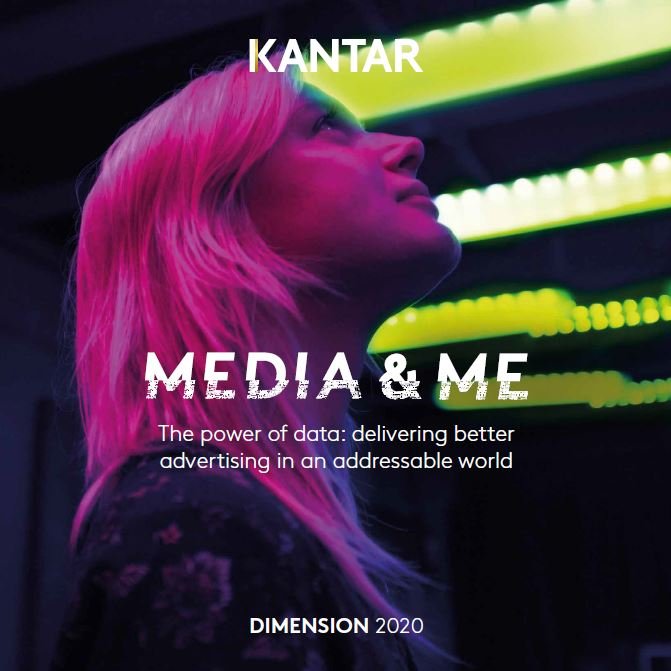#Dimension2020: The Power Of Data In Delivering Better Advertising In An Addressable World
Dimension is Kantar’s latest thinking on some of the biggest communications planning, buying and measurement topics. This year’s study, titled ‘media and me’, investigates how brands, agencies and media owners can bring better advertising that enhances consumer reach and engagement in an addressable world through the power of data.

Data is at the heart of addressable advertising. But with opportunity comes risk, as 71% of consumers say they see the same online ads repeatedly. So, how do you keep advertising on the right side of the line between relevance and unwelcome targeting? How can brands ensure they advertise in a privacy-safe way?
The media world is more personalised than ever before, as consumers are increasingly spending time on their connected personal devices to organize, curate and discover media, in turn the industry designs around these personal preferences, creating opportunities to unlock further growth.
The latest Dimension study looks at both sides of the coin, factoring in responses from 8,000 connected consumers who have access to two or more connected devices, either in the form of a PC or laptop at home or at work, an internet-enabled smart TV, a smart speaker or voice-activated device, or a personally owned tablet or smartphone to connect to the internet. Results were accrued across 8 markets, covering over two-thirds of global advertising spend, or $400bn.
While fieldwork for the study was conducted before COVID-19, which has had a particular impact on media consumption, the fact that people are spending even more time at home on their connected devices means the findings are even more relevant today.
Keeping Online Advertising On The Right Side Of Intrusiveness
Good advertising is about getting the right message to the right consumer, in the right place at the right time. Advertisers and their agencies are continually seeking new ways to reach them, but as online inventory increases, so too does the tsunami of data available, so personalising both the message and the way it’s targeted can improve relevance, reduce wastage and drive efficiencies.
But while consumers welcome relevance, remember that greater personalisation can backfire, as excessive frequency is all too common and blunt retargeting if you’ve already bought the product is particularly annoying. It’s time to rebuild consumer trust in advertising by using the channels they trust most.
There’s also rising consumer cynicism about online advertising, particularly on social media, driven by excessive frequency, unsophisticated retargeting, an over-enthusiastic use of data, and consequent concerns around data privacy. We therefore need to rethink advertising strategy in these times to make advertising ‘great’ or trusted again, while advertising in a privacy-safe way that doesn’t come across as intrusive, where the data is valued across the whole business.
Over half of the connected consumers (54%) we spoke to agree that it’s intrusive when they receive advertising as a result of their past online activity, with connected consumers aged 65+ more likely than younger age groups to be concerned about this, but there’s no one-size-fits-all approach here. Kantar’s TGI Advanced Profiling shows that 96% of consumers are likely to agree that advertising helps them choose what they buy, yet 54% will buy a brand they trust without even looking at price.
Turning Consumer Data Of Today Into Useful Insights For Tomorrow
But it’s not as clear-cut as that. With the issue of trust now central to many brands’ thinking, where you say it is as important as what you say. Keith Weed, former Chief Marketing Communications Officer at Unilever, says: “We have a problem and that is how the public feel about advertising. They simply don’t trust it in a way they once did. Without trust, advertising has no future. A brand without trust is simply a product, and advertising without trust is just noise.”
So, to regain consumer trust in our advertising, it needs to appear in a trusted medium and deliver the message effectively.
We need to question the extent of ad personalisation, as consumers are conflicted between relevance and privacy, with a fear that receiving more tailored content means their online privacy has been compromised. Especially so as it’s not always clear to consumers that data is being collected, nor what it’s being collected for. If consumers can see a tangible benefit in the resulting advertising – a combination of strong creative and responsible use of data – perception could change.
Also remember that online behavioural data only provides half the data we need – it shows what people do, not why they do it. We still have some way to go to understand consumers’ motivations when they’re using different media forms, as behaviour and experiences across different screens isn’t always the same.
Gerhard Louw, Head of International Media Management at Deutsche Telekom, explains: “When we talk about achievable goals to drive business, there isn’t one answer. It isn’t just about brand or performance, it’s about how we work together. It’s not ‘either or’, it’s ‘and’. As marketers, we’re struggling to provide that ‘and’ answer.”
We therefore need to make the most of our data, which usually sits in a walled garden without further analysis. Now, advertisers are becoming more adept at data analytics and journeying towards in-housing of data so as to take control of their media output. There’s also hope of a more collaborative approach to data collection, which may well lead to a more strategic and integrated approach to digital marketing over the next five years.
It’s about shared responsibility for data, which will lead to more effective advertising, though it will take different shapes and forms, from strategy to execution. By restoring consumer trust in a privacy-first world, by using the right data in the right environment with full transparency, we’ll ultimately deliver better advertising in the form of a personalised message received at the right time, in the right place, by the right person.
Click here to access a PDF of the report.





